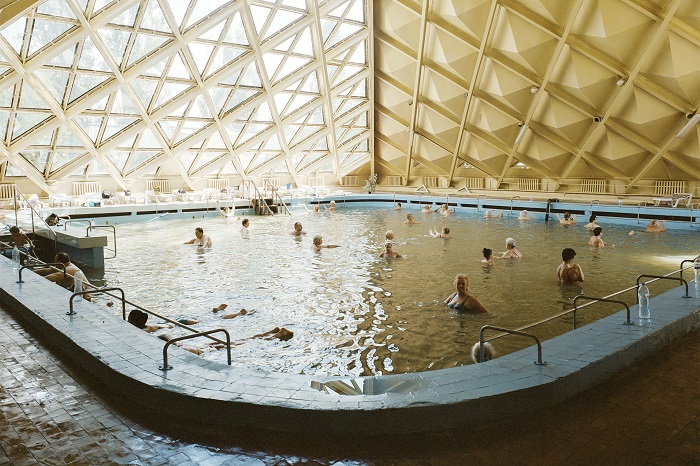
NOVEMBER 15, 2019 – JANUARY 12, 2020 / SMALL EXHIBITION HALL
On November 15, the Zarya Center for Contemporary Art will open the exhibition of photographs “Water Architecture: The Experience of Immersion,” which will transport viewers to the world of the resorts and health spas of the Soviet Union and Russia, including Primorye.
Curated by Anna Petrova, “Water Architecture: The Experience of Immersion” brings together photographs of two different epochs – the Soviet and Post-Soviet. On view will be the works of the father and son duo, Michael and Igor Churakov, Claudine Doury, René Fietzek, Olya Ivanova, Georgy Khrushchev, Daniel Kolchanov, Dmitry Lookianov, Ivan Mikhalov, Igor Mukhin, Egor Rogalev, alongside Michal Solarski, and Anatoly Topuz.
In the Soviet Union, sanatoriums, resorts, and spas took over the former residences and palaces of the tsars. A few were built in the 1930s, leading to a mix of both avant-garde and neoclassical. After World War II, recreational architecture – both buildings for cultural recreation and the care of one’s health – was designed by Modernist architects, whose no-frills approach relied instead on innovative (often to the point of bordering on the absurd) forms.
Back then all these new structures were captured in photographs: father and son, Michael and Igor Churakov, whose archive is today part of the collection of the Shchusev Museum of Architecture, traveled around the far corners of the country, photographing residential housing and administrative buildings. The reporter Anataly Topuz, meanwhile, canvassed the health centers: his color photographs of physiotherapy bear witness to the technical equipment in these facilities, while tapping into the almost surreal atmosphere of the medical interventions into the organisms of Soviet citizens.
In today’s capitalist society, the legacy of the Soviet sanatoriums seems to offer an oasis of prosperity. Having researched the system of the recreational industry in the USSR, British journalist Maryam Omidi produced a book with photographs of health resorts in Russia and Belarus, the Crimea and the Caucasus, Central Asia and the Baltics. Many of the photographers she enlisted to document her case studies took the initiative to continue the research around these spas themselves.
It is this body of photographs that constitute the bulk of the second chapter of our exhibition. Claudine Doury, René Fietzek, Michal Solarski, Dmitry Lookianov, Olya Ivanova and Egor Rogalev contribute images both of modernist architecture, with its trademark silhouettes and interiors, and the moods and expressions on the faces of the people undergoing the physiotherapeutic treatments. Relaxed or concentrated, enduring their discomfort or just plain passed out, the protagonists in these photos are of interest, both aesthetically and anthropologically.
Another chapter of the exhibition focuses on the “Water Architecture” of Primorye, Caucasus, Moscow and the Volga. Selected photographs from Igor Mukhin’s series “Week-end,” Olya Ivanova’s portraits of women at the legendary Chaika, an open-air swimming pool in the center of Moscow, Ivan Mikhailov’s shots from the shores of the Volga in Cheboksary and the bedroom communities of the Moscow River, Georgy Khrushchev’s coverage of the Primorsky “walruses”, and the “shameless bathers” of Pyatigorsk, captured by Dmitry Kolchanov, all build off of the theme, demonstrating natural architectonics, whether holes in the ice or pools amid the rocks, wild beaches or piers.
Egor Rogalev forges a different narrative through his project Oceanization, which explores the resorts and Pioneer camps of Vladivostok. The two-channel video installation draws from archival materials and slides gathered during Rogalev’s time in the Zarya Artist-in-Residency program. The piece examines the complex relationship between the architecture of Vladivostok and the particular features of the landscape, the geological topography and the climate, which it then sets in contrast against two opposing tendencies: the inert desire to neutralize and control outside influences and the poetic quest for more open and expressive means of interacting with the environment.
Images of mud, caves, hot springs, oxygen baths, therapeutic exercises, vertical tanning beds and salt rooms immerse the user (and the viewer) into another reality, making summer vacations such a pleasant experience. Whether taken on its surface or understood more metaphorically, “Water Architecture” borders on the surrealist and the absurd, deeply immersing its viewer in the sensations of holiday-makers and vacationers, designing and building, swimming and diving.
This project was made possible through loans of photographs from the archives of the Shchusev State Museum of Architecture and the collection of Sergey Shestakov (@ussr.photo).